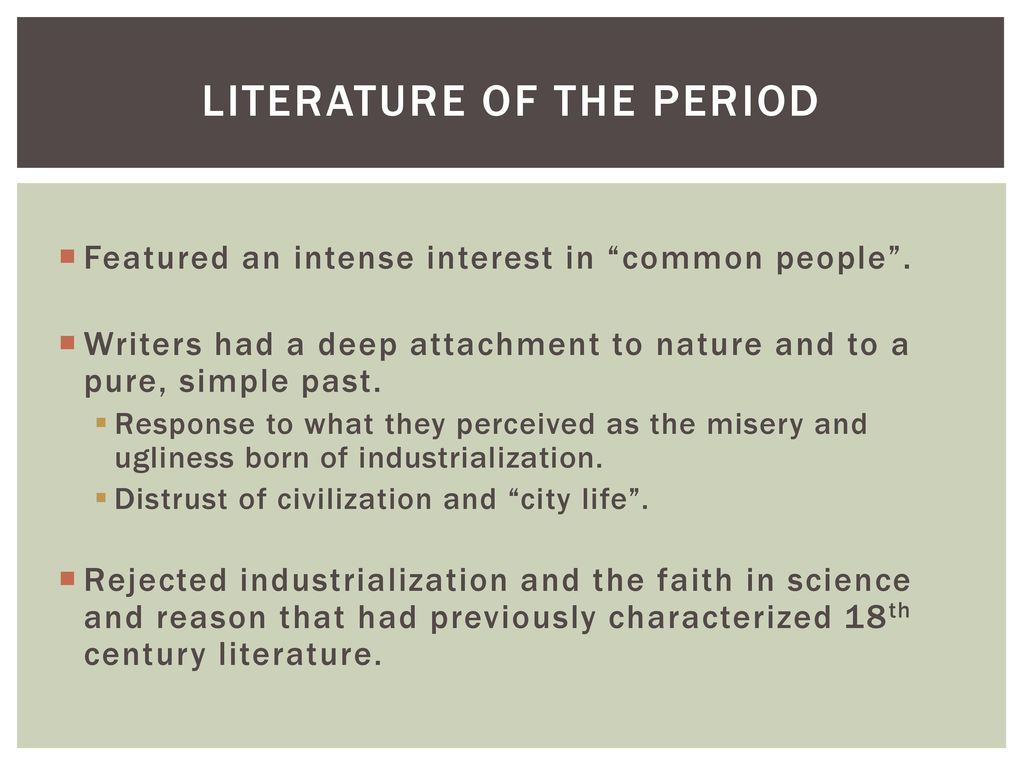Romantic Age (1798-1824)

The Romantic period is the most fruitful period in the history of English literature.
The revolt against the classical school which had been started by writers like Chatterton, Collins, Gray, Busins Cowper etc reached its climax.
Popular poets like Wordsworth, Coleridge Byron, and Shelly Keats belonged to this period.
⤵️
This period started in the year 1798 with the publication of the lyrical Ballads by Wordsworth.
The preface written by Wordsworth and Coleridge also changed the wave of the classical school.
Here Wordsworth touched on the simplicity and naturalness of the diction.
According to Wordsworth what he wrote was “to be considered as an experiment”.
⤵️
He opined that the language of the common people should be adopted for the purpose of pleasure
He chose the language of the common people because.
He thought it was the most sincere expression of the deepest and rarest passion and feelings
The romantics wanted the poets to breathe the fresh air of the hills, and live in the lap of nature.
They substituted the heroic couplet with simple and natural diction.
They turned from the artificial life of the classical school to the lap of nature.
⤵️
They gave importance to imagination and emotion.
Against the intellectualism of the classical school.
There was freedom of expression. It was said that just as-
⤵️
‘Liberty of individual’ was the watchword of the French Revolution.
‘Liberty of the nation from foreign domination’ was the ‘watch wood’ of the American War of Independence.
In the same way for the poet, the ‘liberty from rules’ was the ‘watchword’.
This was the romantic movement
⤵️
It was also called the romantic revival because
All these characteristics belonged to the Elizabethan age
Thus the Elizabethan age can also be called the first romantic age in English literature.
⤵️
But there was a difference between the Elizabethan age and the Romantic age.
The romantic spirit looked for something once was
But now it was lost.
So the romantics looked back to their master of the Elizabethan age.
So they wanted to recapture the memory
So that it would not fade away.
The romantics dealt with events of everyday life.
They tried to prove that, that was commonplace things treated in a simple way would be very interesting.
Celoridge’s contribution was the ‘supernatural’ ardour.
Thus ‘naturalism’ and ‘supernaturalism’ became two significant wheels of the romantic movement
‘naturalism’ include love for nature and man.
‘supernaturalism’ established the connection between the ‘visible world and the other world that is unseen.
Love for the post also was one of the characteristics of the romantic revival.
Wordsworth, Coleridge Southey and Scott belonged to the first romantic generation.
The second generation was Byron Shelley, Keats, Leigh Hunt, Hazlitt and others.
⤵️
The struggle with the French empire had made the English poor.
The political and social agitation again cropped up.
The powerful became more powerful.
Here the younger Romantic attacked the social order.
Thus romanticism in the second stage becomes a literature of social conflict.
But both generations of romanticism shared the same literary beliefs and ideals.
They were all innovators in the form of the substance of poetry.
All were against the Pseudo-classical models.
They condemned the theory of the “poetic diction” of the 18th century.
They rejected the way the couple was used which was in no way like a Pope.
The romantics preferred either blank verse or stanzas or shorter lyrical poetry.
The prose-writers of romantic revival also broke with their predecessors.
They rejected the shorter and lighter style of the 18th century.
The Prose writers of the Romantic revival went back to the Renaissance and the style of Sir Thomas Browne. (Jacobean & Caroline prose)
⤵️
Much of the prose of this age was a critical study of literature.
As we find in Lamb, Quinney and others.
The Romantics opened up new avenues of literature.
⤵️
Romanticism was characterised by an excess of emotions.
The novels excelled in extravagant stories of supernatural fervour.
These were the school of exaggerated romances.
Mrs Radcliff was one of the important novelists.
The romantic age, the age of poetry was the proper medium for the expression of emotions and imaginative sensibility.
In this age we find the human spirit derives new richness from outward objects and philosophical ideas.
⤵️
The poets began to draw ideas from different sources-
Mountains rivers, lakes etc.
The supernatural fervour.
Medieval chivalry
Art & Mythology of Greece
Prophecy of the ‘golden age’
⤵️
All these produced a sense of wonder.
And it had to be put in a proper form.
That is why the ‘romantic age’ is also called the ‘Renaissance of Wonder’
The poets attempted to capture and convey the influence of nature.
The essence of romanticism was that literature must reflect all that is spontaneous and unaffected in nature.










0 Comments